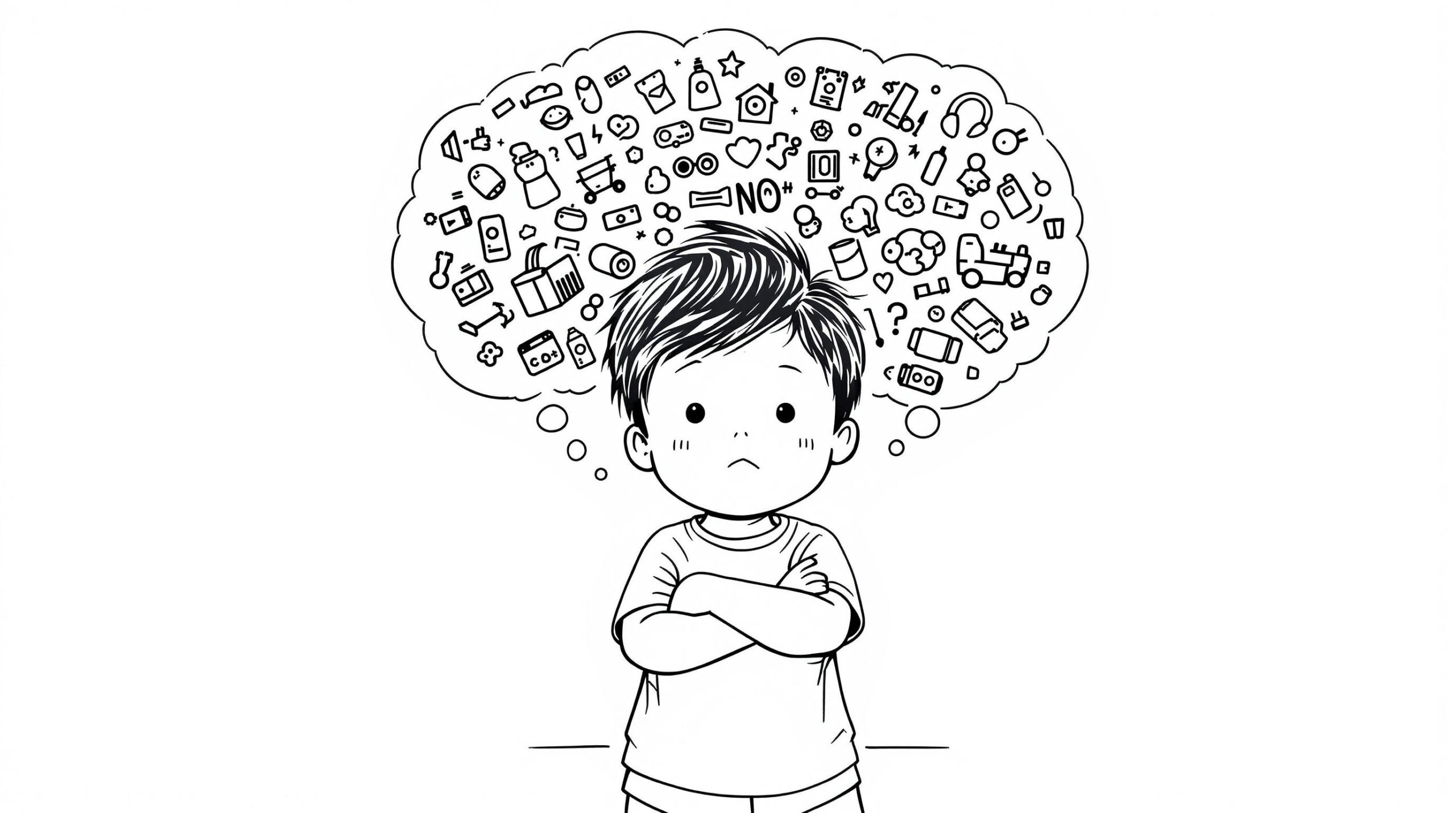Table of Contents
ToggleToddlers saying “no” to everything can be a challenging phase for parents. As a parent, you might find yourself wondering why your little one seems to resist every request or suggestion. This behavior, while frustrating, is actually a normal part of toddler development. Let’s explore why toddlers go through this phase and how you can respond effectively.
The “No” Phase: A Normal Part of Toddler Development
Your toddler’s frequent use of “no” is closely tied to their cognitive development. During the preoperational stage, which spans from ages 2 to 7, children begin to engage in symbolic thought. This means they can use words, images, and objects to represent other things.
Toddlers often use “no” as a way to assert their growing independence and explore boundaries. It’s their way of testing the waters and figuring out where they stand in relation to the world around them. By 18 months, many toddlers are engaging in simple pretend play, using figures or objects as agents of their own actions. This newfound ability to manipulate their environment, even in imagination, can lead to an increased desire for control in real-life situations.
Remember, your child isn’t trying to be difficult. They’re simply exercising their developing cognitive skills and attempting to carve out their own identity. Understanding this phase can help you approach it with patience and empathy.

Understanding the Emotional and Language Development Behind “No”
Your toddler’s inclination to say “no” is also closely tied to their emotional and language development. Around 12 to 18 months, separation anxiety often peaks, contributing to clingy behavior and tantrums. This anxiety can manifest as resistance to your requests or suggestions, as your toddler grapples with the concept of being separate from you.
At the same time, toddlers are rapidly acquiring gross motor and receptive language skills. However, their expressive communication abilities often lag behind. This mismatch can lead to frustration, with “no” becoming a catch-all response when they can’t articulate their true feelings or desires.
Another crucial developmental milestone is object permanence, which typically develops around 9 months. This understanding that objects continue to exist even when out of sight can contribute to your toddler’s increased assertions of will. They now know that things (and people) exist beyond their immediate perception, which can both comfort and distress them, leading to more complex emotional responses.
The Frustration Factor: Why Toddlers Resort to “No”
Temper tantrums are common between 12 to 24 months, largely due to the rapid acquisition of skills coupled with limitations in communication. Your toddler is learning and growing at an incredible rate, but they often lack the words to express their needs, wants, and feelings adequately.
Additionally, toddlers may assign imaginary properties to objects, leading to further frustration when reality doesn’t align with their expectations. For example, your child might become upset when a toy car doesn’t drive itself like the ones they’ve seen on TV.
By 12 months, most toddlers show excitement about exploring their environment. However, this curiosity is often accompanied by increased separation anxiety. The result? A complex emotional landscape where your child simultaneously wants to assert independence and seek comfort, often expressing this conflict through the use of “no”.
Strategies for Managing Frustration
To help your toddler navigate this frustrating period:
- Offer choices when possible, giving them a sense of control
- Use simple words and gestures to help them express themselves
- Provide plenty of opportunities for safe exploration
- Maintain a calm demeanor, even when they’re upset
- Acknowledge their feelings: “I see you’re feeling frustrated”
Positive Reinforcement: Encouraging Compliance Without Conflict
When dealing with a toddler who seems to say “no” to everything, positive reinforcement can be a powerful tool. Instead of focusing solely on the “no,” try to praise and reward compliance. This approach can help shift your child’s behavior over time.
Use simple and clear language that your toddler can understand. Aim for a sixth-grade reading level or lower in your communication. For example, instead of saying, “It’s time to cease your current activity and prepare for bed,” you might say, “Let’s put the toys away and get ready for sleep.”
Active parental involvement in setting clear expectations significantly impacts a child’s behavior. When you consistently reinforce positive behaviors, you’re teaching your child what’s expected of them in a way that’s easy for them to understand and follow.
Examples of Positive Reinforcement
- Offer specific praise: “Great job putting your toys in the box!”
- Use non-verbal rewards: A high-five or a hug can be powerful motivators
- Create a sticker chart for completing tasks
- Offer small privileges for good behavior: “Since you helped clean up, you can choose the bedtime story tonight”
Setting Boundaries and Maintaining Consistency
Setting clear boundaries is crucial when managing a toddler’s behavior. Establish rules and explain the reasons behind them in simple terms. For instance, “We hold hands in the parking lot to stay safe from cars.”
Consistent parenting practices help reduce tantrums and the frequency of saying “no.” When your child knows what to expect, they’re less likely to push back against every request. Create a predictable environment through consistency in your rules, reactions, and daily routines.
Tips for Maintaining Consistency
- Create a visual schedule of daily activities
- Use the same phrases for recurring situations
- Ensure all caregivers are on the same page regarding rules and consequences
- Follow through with stated consequences, every time
- Acknowledge and praise when your child follows the rules
Creating a Supportive Environment to Reduce “No” Responses
A supportive environment can significantly reduce your toddler’s tendency to say “no” to everything. Provide emotional support and validation to help your child feel secure. When they feel understood and supported, they’re more likely to cooperate.
Establish a structured environment with predictable routines. This predictability can help your toddler feel more in control, reducing their need to assert themselves through constant refusals.
High-quality parent-child interactions are crucial for healthy development. Spend time each day engaging in activities your child enjoys, giving them your full attention. This dedicated time can strengthen your bond and make your child more receptive to your guidance.
Creating a Toddler-Friendly Environment
- Childproof your home to reduce the need for constant “no’s”
- Create a designated play area where your child can explore safely
- Use open-ended toys that encourage creativity and problem-solving
- Incorporate music and movement into daily routines
- Provide opportunities for sensory play
Navigating Family Dynamics and Cultural Influences
Family support plays a crucial role in managing the “no” phase. Grandparents, siblings, and other family members can provide additional patience, understanding, and positive reinforcement. However, it’s important to ensure all family members are consistent in their approach to avoid confusing your toddler.
Families from diverse backgrounds may face different challenges, but supportive interactions remain key across cultures. In the NICHD study, 40% of children lived in families defined as poor or near-poor, yet supportive interactions were crucial for their development regardless of socioeconomic status.
Addressing Cultural Differences
- Discuss parenting approaches with extended family members
- Be open to cultural practices that promote positive behavior
- Seek support from community resources if needed
- Remember that every child is unique, regardless of cultural background
Encouraging Independence While Maintaining Control
Encouraging your toddler’s independence can actually help reduce their need to say “no” to everything. When children feel they have some control over their lives, they’re often more cooperative. However, it’s important to balance this independence with appropriate boundaries.
Offer choices within limits. For example, “Would you like to wear the red shirt or the blue shirt today?” This gives your toddler a sense of control while still ensuring they get dressed. Allow your child to help with simple tasks, like putting away toys or helping to set the table. This fosters a sense of capability and cooperation.
Fostering Independence
- Create a “helper” chart with age-appropriate tasks
- Teach self-care skills like hand washing and dressing
- Allow extra time for your child to complete tasks independently
- Praise efforts, not just results
- Set up the environment for success (e.g., low shelves for toys)
Helping Your Toddler Understand and Express Emotions
Often, a toddler’s “no” is a reflection of underlying emotions they can’t express. Helping your child understand and name their emotions can reduce their reliance on “no” as a catch-all response.
Use simple language to label emotions: “You seem angry that we have to leave the park.” Validate their feelings while still maintaining boundaries: “I understand you’re upset, but it’s time to go home now.” Over time, this helps your child develop emotional intelligence and better communication skills.
Emotional Literacy Activities
- Read books about feelings
- Use a feelings chart with pictures
- Play emotion guessing games
- Model naming your own emotions
- Create a calm-down corner with soothing items
Remember, the “no” phase is temporary. With patience, consistency, and positive reinforcement, you can help your toddler navigate this challenging but important developmental stage. By understanding the reasons behind their behavior and responding with empathy and firmness, you’re laying the groundwork for positive communication and behavior in the future.
Sources:
Jean Piaget’s Stages of Cognitive Development
Evidence-based milestone ages as a framework for developmental surveillance
The NICHD Study of Early Child Care and Youth Development












